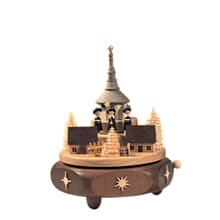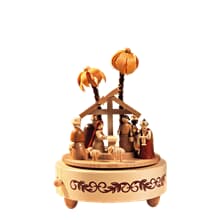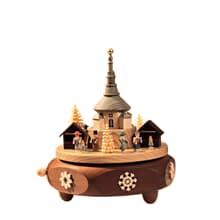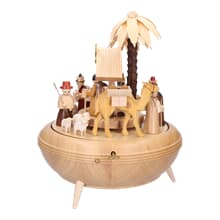Music boxes from the Erzgebirge

Music boxes from the Erzgebirge - fairytale Christmas decorations to play with and give as gifts
The Erzgebirge can be eerily quiet as soon as snow and frost hit the landscape. The miners' work was no longer possible in such frozen times. But until the next spring, Erzgebirge folk art devised all kinds of gadgets made of pewter, wood or silver to break this eerie silence. Certainly, the first music box inspired the confidence of many children in this region. To this day, carved and turned figures, along with their ingenious clockworks, enchant young and old far beyond the Erzgebirge.
Features of a music box
Jewellers originally devised filigree gadgets for the wealthy customers of their time. The music box from the Erzgebirge was one of these versatile gadgets in the 18th century - only without a clock. The purpose of the toy was to set the scene depicted by pressing a button. Music was supposed to enhance the magic of such movement. The functionality of this masterpiece is modelled on the combs and rollers of an organ box. In their function in a music box, however, they are called reeds.
The idea behind this musical mechanism was found in Erzgebirge folk art by clockmakers. They created signet rings, pocket watches and even snuff boxes that played a melody at the push of a button. In its realisation as a music box, however, the mechanism can do much more. It is like a play in miniature. To this day, the Erzgebirge with its manufactories is famous worldwide for this form of Christmas art.
The manual production of music boxes is still a masterpiece of handicraft. Wooden or metal figures are attached to a base. In many models, the base can be completely retracted under a lid. A flick of the wrist - and the toy starts to move pleasantly. This makes it ideal for enchanting the rigidity of wintertime with acoustic and visual impressions for a few minutes.
Difference between music box and musical clock
A musical clock contains melodic components that are linked to the movement of the hands. At every hour, half hour or other beat, the sequence of tones of the musical clock is sounded. The movement of figures is not intended in a musical clock. Musical clocks on towers are an exception. Here the connection between movement and mechanics is already connected.
The Erzgebirge folk art took up the principle of the sequence of tones again in a toy that is still very popular today. The first music boxes, often confused with musical clocks, had rollers that played a fixed melody. Later, there was also a music box with plate rollers. Now the melody could be changed at will. To this day, both mechanisms continue to coexist in handicrafts from the Erzgebirge.
Construction and function of music boxes
The housing of music boxes from the Erzgebirge region is still mainly made of wood and requires a high level of craftsmanship. Scenarios of the region, landscapes and the like are visually depicted on the top of the box. Invisible to the observer, this wooden outer structure houses a sound work with very many filigree components. These can certainly be compared to the components in a mechanical clockwork. When the mechanism is set in motion by winding it, a tone comb produces a certain sequence of sounds via tone tongues. These produce a song. At the same time, the figures on the case rotate.
It would not be the imaginative Erzgebirge folk art if it had not thought about a single melodic sequence. Thus, there are various designs of music box that either play several perforated plates (rollers) one after the other or where the melody mechanism can be changed by moving pins for new sounds. The latest developments from the Erzgebirge even allow a variety of sounds, almost like an orchestra with loud and soft sound effects to enchant their listeners and viewers.
Model variants of the Christmas toy from the Erzgebirge
The principle of sound production is the striking of reeds of different lengths in a precisely defined sequence. The striking of steel pins produces the audible sound. However, what thrilled people in the Erzgebirge in the days of invention soon had a recognisable disadvantage: a music box could only play one melody. So resourceful clockmakers and craftsmen tinkered with making scenarios and sounds a little more varied. To this day, Erzgebirge folk art primarily produces the following two versions of a mechanically operated music box:
Music from the roller
In order for the first music boxes with rollers to work, they were initially more crude than music boxes. The musical mechanism worked by means of a tongue comb and a sprocket wheel. In order to be able to build ever finer toys of this kind, a comb of tongues was built into the box instead of individual teeth or groups of teeth in the Erzgebirge and other places of manufacture. This made it possible to enrich the Erzgebirge folk art also with very small models of low height.
A music box with a cylinder can play several melodies, but no more than six. These are always played one after the other, i.e. not interchangeably. In principle, the reels can be exchanged if other music is desired. However, in today's production of the companies in the Erzgebirge, such variants with a fixed roller are more common.
Music from the perforated plate
The production of rollers for the music box from the Erzgebirge was a time-consuming process. The production costs of a company were correspondingly high. In addition, the owners of these musical gems from the Erzgebirge could now change the melody at will. But despite all the progress, this hard-wearing Erzgebirge folk art also had a disadvantage. While a cylinder could play up to six melodies, the music box could only play one melody per plate.
Music boxes with a perforated plate were driven by a powerful spring mechanism. In the early models, this was set in motion by a crank. Today's models have a small key that starts the play and movement either from the side of the box or from the floor. Roughly speaking, the children's toy from the Erzgebirge with this perforated plate mechanism, which was a popular Christmas gift, can even be regarded as the forerunner of the gramophone, which appeared much later.
Successor to the precision mechanical masterpiece
To this day, music boxes with mechanical drives are still being built in manufactories and companies. However, the possibilities of melodies and motifs have become diverse. Up to 18 melodies in several voices (for example with bell and flute) and far more than square boxes can now be admired. The classic toys are complemented by models with battery operation. Instead of being wound up, snow globes or merry-go-rounds, moose or snowman play their songs at Christmas time from an electronic chip inside the figure.
Movement, motifs and music make the music box a popular collector's item, or gift at Christmas, internationally to this day. Not least because of the detailed miniature world that tells its own little story on each music box. Because of this popularity, even modern electronic successors do not do without this combination. Snow flurries run automatically in a snow globe to the sounds. Dog or moose or other figures wiggle and bark along with it, greet or even flash in colour to the entertaining game.
Superlatives of the music box in its
Superlative toys can regularly be admired at Christmas markets in many places at Christmas time. The figures and the music box itself are taller than the human visitors and stand out with their height. In Neuhausen in the Ore Mountains, you can even marvel at what is currently the world's largest music box with a height of 6.89 ft (2.10 m). It works perfectly and moves every day on the hour like a giant theatre. The figures have various motifs and tell the story of the fairy tale "Nutcracker and Mouse King" (E.T.A. Hoffmann). The giant tin plays the melody from Tchaikovsky's Nutcracker.
But even in miniature, music boxes from the Erzgebirge can be described as superlatives. After all, Erzgebirge folk art has now established them not only for Christmas, but also for Easter and even extra-seasonal themes. Wood as the housing material makes the magic of a music box even in modern times. Whether cranking, turning or pressing - the resourceful manufacturers from the Erzgebirge leave that to the taste of the small and large music box fans of craftsmanship.
Conclusion:
The Erzgebirge with its arts and crafts stands for Christmas trends as well as for functional toys made of wood. With the music box, Erzgebirge folk art combines a beautiful sight, filigree figure play in a detailed miniature world and the accompaniment of pleasant sounds. A modern music box can also have an electronically functioning melody chip for its movement instead of a perforated plate and roller. But classic, mechanically operated versions continue to be coveted worldwide as toys and collector's items, especially at Christmas time.






